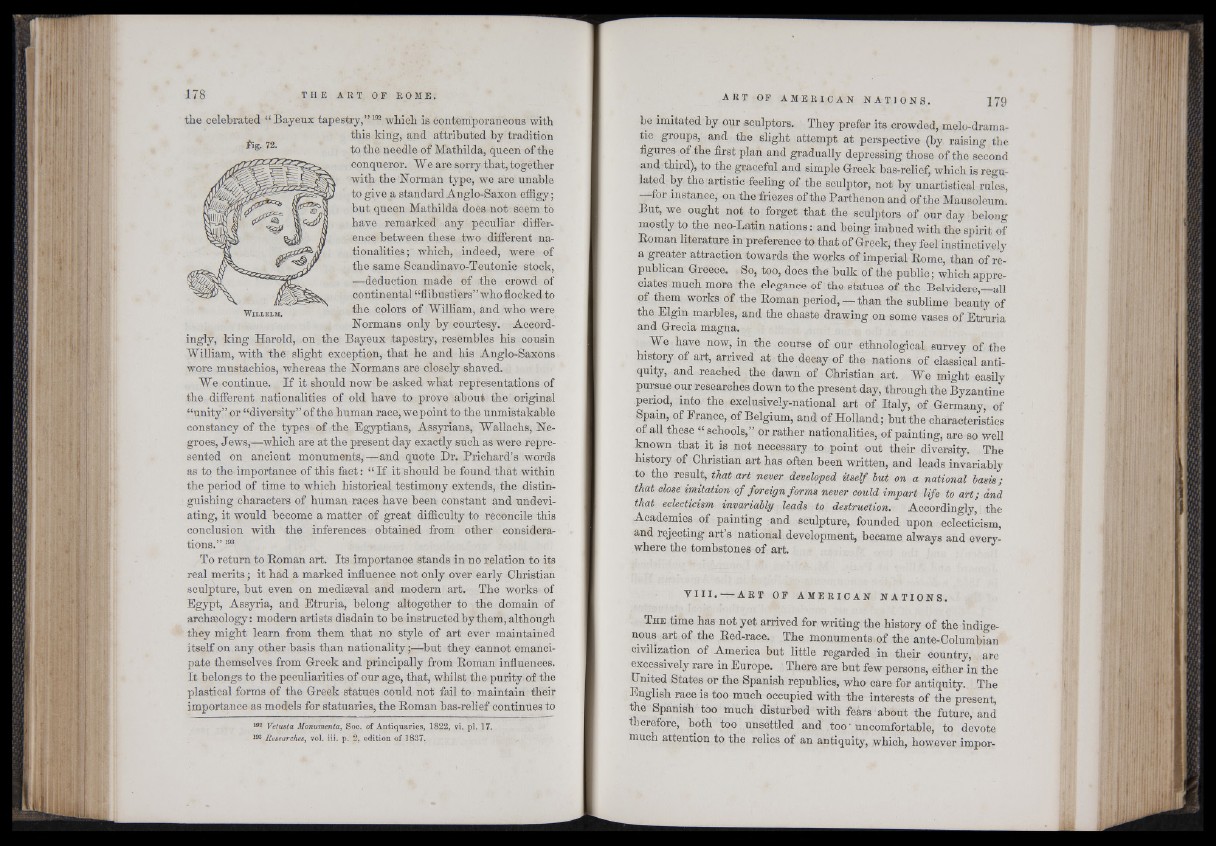
the celebrated “ Bayeux tapestry,” 192 which is contemporaneous with
this king, and attributed by tradition
to the needle of Mathilda, queen of the
conqueror. We are sorry that, together
with the Norman type, we are unable
to give a standard Anglo-Saxon effigy;
but queen Mathilda does not seem to
have remarked any peculiar difference
between these two different nationalities;
which, indeed, were of
the same Scandinavo-Teutonie stock,
—deduction made of the crowd of
continental “flibustiers” who flocked to
the colors of William, and who were
Normans only by courtesy. Accordingly,
Ìig . 72.
WlL L E LM.
king Harold, on the Bayeux tapestry, resembles his cousin
William, with the slight exception, that he and his Anglo-Saxons
wore mustachios, whereas the Normans are closely shaved.
We continue. I f it should now be asked what representations of
the different nationalities of old have to prove about the original
“unity” or “diversity” of the human race, we point to the unmistakable
constancy of the types of the Egyptians, Assyrians, Wallachs, Negroes,
Jews,—which are at the present day exactly such as were represented
on ancient monuments,—and quote Dr. Prichard’s words
as to the importance of this fact: “ If it should be found that within
the period of time to which historical testimony extends, the distinguishing
characters of human races have been constant and undevi-
ating, it would become a matter of great difficulty to reconcile this
conclusion with the inferences obtained from other considerations.”
199
To return to Roman art. Its importance stands in no relation to its
real merits; it had a marked influence not only over early Christian
sculpture, but even on mediaeval and modern art. The works of
Egypt, Assyria, and Etruria, belong altogether to the domain of
archaeology: modem artists disdain to be instructed by them, although
they might learn from them that no style of art ever maintained
itself on any other basis than nationality;—but they cannot emancipate
themselves from Greek and principally from Roman influences.
It belongs to the peculiarities of our age, that, whilst the purity of the
plastical forms of the Greek statues could not fail to maintain their
importance as models for statuaries, the Roman bas-relief continues to
192 Vetusta Monumenta, Soc. of Antiquaries, 1822, vi. pi. 17.
193 Researches, vol. iii. p. 2, edition of 1837.
be imitated by our sculptors. They prefer its crowded, melo-drama-
tie groups, and the slight attempt at perspective (by raising the
figures of the first plan and gradually depressing those of the second
and third), to the graceful and simple Greek bas-relief, which is regulated
by the artistic feeling of the sculptor, not by unartistical rules,
—for instance, on the friezes of the Parthenon and of the Mausoleum.
But, we ought not to forget that the sculptors of our day belong
mostly to the neo-Latin nations: and being imbued with the spirit of
Roman literature in preference to that of Greek, they feel instinctively
a greater attraction towards the works of imperial Rome, than of republican
Greece. So, too, does the bulk of the public; which appreciates,
much more the elegance of the statues of the Belvidere, all
of them works of the Roman period, — than the sublime beauty of
the Elgin marbles, and the chaste drawing on some vases of Etruria
and Grecia magna.
I kave now> in the course of our ethnological survey of the
history of art, arrived at the decay of the nations of classical antiquity,
and reached the dawn of Christian art. We might easily
pursue our researches down to the present day, through the Byzantine
period, into the exclusively-national art of Italy, of Germany, of
Spain, of France, of Belgium, and of Holland; but the characteristics
of all these “ schools,” or rather nationalities, of painting, are so well
known that it is not necessary to point out their diversity. The
history of Christian art has often been written, and leads invariably
to the result, that art never developed itself but on a national basis;
that close imitation of foreign forms never could impart life to art; and
that eclecticism invariably leads to destruction. Accordingly," the
Academies of painting and sculpture, founded upon eclecticism,
and rejecting art’s national development, became always and everywhere
the tombstones of art.
V I I I . — A R T OF A M E R I C A N N A T I O N S .
T he time has not yet arrived for writing the histoiy of the indigenous
art of the Red-race. The monuments of the ante-Columbian
civilization of America but little regarded in their country, are
excessively rare in Europe. There are but few persons, either in the
United States or the Spanish republics, who care for antiquity. The
English race is too much occupied with the interests of the present,
the Spanish too much disturbed with fears about the future, and
therefore, both too unsettled and too - uncomfortable, to devote
much attention to the relics of an antiquity, which, however impor